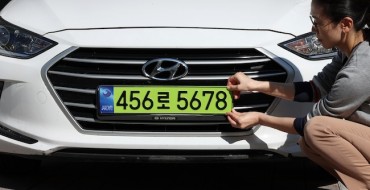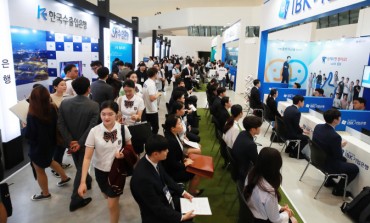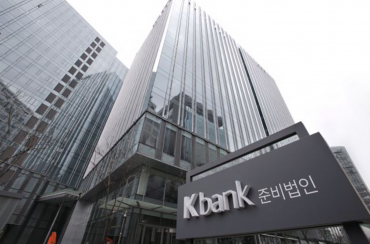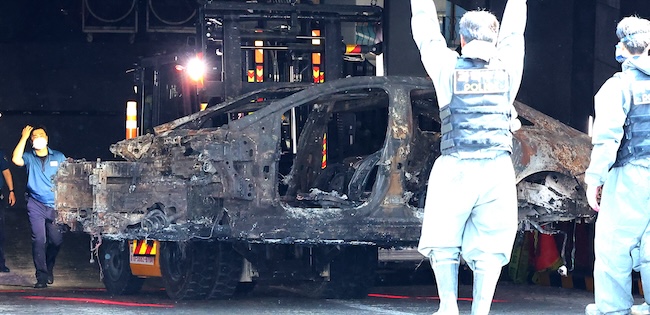
Police move an electric Mercedes-Benz sedan from the underground parking lot of an apartment building after completing their probe in Incheon, 27 kilometers west of Seoul, on Aug. 5, 2024. A fire broke out in the car after it exploded on Aug. 1, resulting in 22 residents and a firefighter being hospitalized. Around 40 cars were burned, and an additional 100 cars in the parking lot were damaged. (Image courtesy of Yonhap)
SEOUL, Aug. 7 (Korea Bizwire) — The recent electric vehicle fire incidents involving Mercedes-Benz and Kia models could not have come at a worse time for the local automotive industry, which has been eagerly preparing to introduce ambitious new electric models to tackle the so-called EV adoption chasm.
While waiting for the official investigation results, the industry is fretting over the spike in consumers’ doubts over the safety of what are supposed to be cutting-edge, advanced cars for the future.
The latest scare surrounding electric cars started last Thursday, when a Mercedes-Benz EQE vehiclecaught fire in an underground parking garage inside an apartment complex in Incheon, 27 kilometers west of Seoul.
The fire gutted the facility, completely ravaging around 40 nearby vehicles and partly damaging some 100 additional cars. Over 800 residents were staying in temporary shelters due to a disruption in the water and power supply.
Police confirmed that no external shock was inflicted on the vehicle while it was parked for three days before it burst into flames. Security camera footage showed smoke billowing from the Mercedes before it suddenly exploded.
On Tuesday, another fire incident was reported involving a EV6 model by South Korean automaker Kia Corp. in Geumsan county, South Chungcheong Province.
The fire apparently began at the lower part of the EV6, which ahad a charger plugged in at the time, where the battery is located. It was extinguished in about 90 minutes with no additional damages.
The police plan to send the vehicle to Kia for a detailed investigation into the cause of the fire.
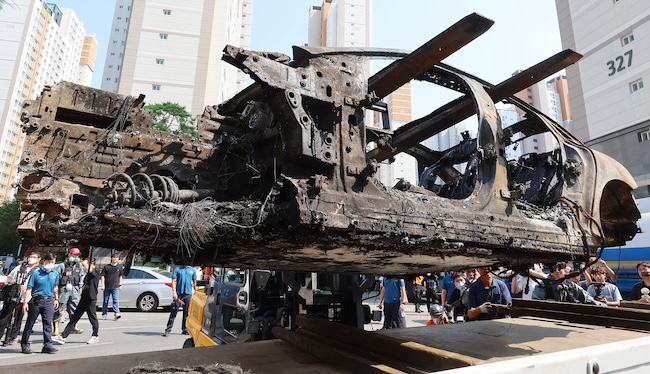
Police move an electric Mercedes-Benz sedan from the underground parking lot of an apartment building after completing their probe in Incheon, 27 kilometers west of Seoul, on Aug. 5, 2024. A fire broke out in the car after it exploded on Aug. 1, resulting in 22 residents and a firefighter being hospitalized. Around 40 cars were burned, and an additional 100 cars in the parking lot were damaged. (Image courtesy of Yonhap)
The Mercedes was found to have a battery supplied by Chinese firm Farasis Energy Inc., while that of the EV6 was reportedly made by South Korean firm SK On Co.
As EVs have become more and more common, so has the number of fire cases. In 2018, there were three reported EV fire cases. Last year, the tally jumped to 72.
With a series of new launches scheduled from the second half of this year through next year, concerns remain within the industry that consumers may avoid purchasing electric vehicles.
Domestic industry leader Hyundai Motor Co. isseeking a breakthrough in its effort to popularize EVs with its new A-segment Casper Electric sub-compact model, while Kia has just released the EV3, the company’s latest crossover electric car, to positive reviews.
GM Korea, the South Korean unit of General Motors Co., is also set to launch its Equinox compact electric SUV here, while Polestar Automotive Holding plans to release its Polestar 4 electric SUV coupe also in the second half of the year.
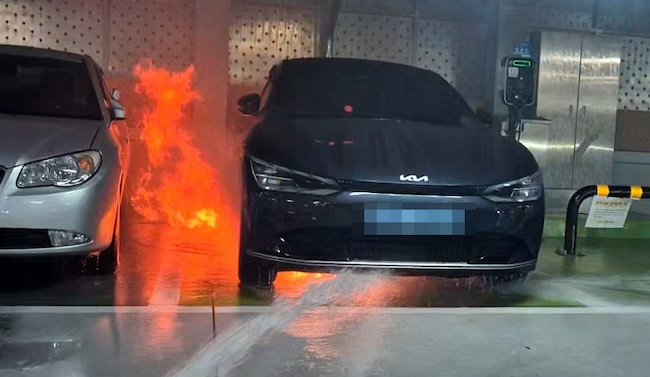
This photo provided by the Geumsan Fire Station on Aug. 6, 2024, shows a fire breaking out underneath a Kia EV6 car in the county in South Chungcheong Province. (Image courtesy of Yonhap)
The domestic EV market is in desperate need of a rebound. According to automotive market tracker CarIsYou, EV sales in South Korea from January to July this year totaled 80,613, down 13.4 percent from the same period last year.
“During an EV battery fire, temperatures can exceed up to 1,000 C, causing the battery cells to melt completely,” an industry insider said. “It could make it difficult to pinpoint the exact cause of the fire.
“If consumer concerns about the safety of electric vehicle batteries are not alleviated, the transition to full electrification could inevitably be delayed,” he added.
Following the Incheon accident, some apartment complexes and office buildings have prohibited EVs from entering underground parking garages.
Local battery manufacturers are also monitoring the situation closely.
Roughly speaking, battery cells are essentially the key component that determines the performance of EVs. They account for about half of an EV unit’s price.
In the case of the vehicle involved in the Incheon accident, batteries made by Farasis Energy have experienced recalls in the United States and China in the past due to fire risks.
Lee Ho-geun, an automotive professor at Daeduk University, said, “Given that Farasis batteries have been pointed out for stability issues in the past, I cautiously predict that the cause might be a design or manufacturing defect.”
Experts advise that to prevent EV fires during heat waves, it is best to avoid using ground-level chargers and to use slow chargers, ensuring that the battery is not charged beyond 90 percent.
“By charging only up to 85 percent with a slow charger, you can prevent over 95 percent of EV fires caused by thermal runaway,” Lee said.
(Yonhap)



